From the logbook of “Nam Kok”, July 2012
1. Intro
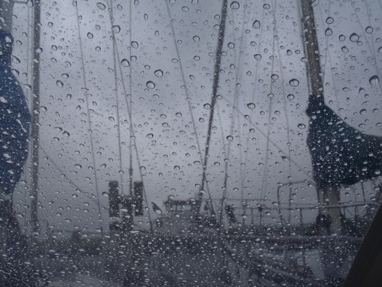 3 years had gone by in Warns in Friesland with our sailboat, the “Nam Kok” after our very exciting honeymoon at that time. Since that we have been sailing the Ijsselmeer up and down and know each of these traditional, old harbors, from glorious decades in the past. Also becoming experienced with our ship, mostly at quite heavy conditions in the Netherlands, mostly at least with one reef in the main. We know that “Nam Kok” loves to fly on the reach down-wind, not easy up-wind. And we love to jibe her, but we are also fine, getting her through the wind with the nose for tracking. 3 years of Ijsselmeer, 3 years of rain, shower, strong winds and bucketwise gusts. Where ever we have been at all these times and locations, big, black clouds were approaching. Regularly, as if it was somehow related to us. Somehow we felt not being welcome anymore in our marina in Warns. The people got scared of bad and stormy weather, seeing us.
3 years had gone by in Warns in Friesland with our sailboat, the “Nam Kok” after our very exciting honeymoon at that time. Since that we have been sailing the Ijsselmeer up and down and know each of these traditional, old harbors, from glorious decades in the past. Also becoming experienced with our ship, mostly at quite heavy conditions in the Netherlands, mostly at least with one reef in the main. We know that “Nam Kok” loves to fly on the reach down-wind, not easy up-wind. And we love to jibe her, but we are also fine, getting her through the wind with the nose for tracking. 3 years of Ijsselmeer, 3 years of rain, shower, strong winds and bucketwise gusts. Where ever we have been at all these times and locations, big, black clouds were approaching. Regularly, as if it was somehow related to us. Somehow we felt not being welcome anymore in our marina in Warns. The people got scared of bad and stormy weather, seeing us.
So we spent the sunniest and warmest weeks on the ladder at our new home, during renovation, in the background the vuvuzelas of the WM in South Africa. Nothing to do with sailing.
Despite and all of that, the Netherlands has impressed us. We never want to miss that time, being jailed in ice (50 cm!) during winter. A couple of thousands of pilsjes (Lager-beer), always the last one… BBQ´s under the umbrella. Regatta as losers, awarded with red lantern. And a sensational October at anchor with champagne and bikini.
Especially the harbor acquaintances, for instance with the “Flying fish” and the “Sol y son” are exceptional, leading hopefully into friendship.
End of June 2012. Since spring we were working like hell to free the ship from mold fungus and the deck from rust and rifts. Oven, chart plotter with AIS and life raft were upgraded and something else we installed on board, what was actually not really necessary to cross the Ijsselmeer; we provided “Nam Kok” with a self-steering wind vane, dedicated for longer distances, and that was exactly that, what we were longing for.
Three weeks time for our journey, three weeks of holiday. The first third towards the south and south-west, two thirds to return. Destination: Belgium and France at the channel. The desire on top: Landing on the island, happy and glorious. We were provided with all necessary foreign courtesy ensigns, including the one of the Queen. But I had to warn my wife Corinna, that in case if we ever would reach the United Kingdom I could never get her back home again, probably only by pulling her ears…, we felt well prepared.
2.The first leg to the North sea
As usual the wind was blowing since several days before our departure. The sea of the Ijsselmeer was foaming in its also usual manner. The short-term forecasts promised improvement, the long-term forecasts said something about altering weather conditions during the next weeks. Anyway, we had to wait until Monday to get first the gas approval for our new installed oven. Shortly before full-moon the wind died down as predicted and we firstly targeted Amsterdam, in order to reach the North-sea after crossing Ijssel- and Markermeer.
Monday, 2nd of July.
With the certified oven we started our trip and reached the Ijsselmeer right after the first lock at Stavoren. There was barely only one sail looming on the horizon. The sky was bright, the wind continued backing to south-south-west, force 4. We set all our sails, heading straight eastbound and shortly later we could to turn windward, then cruising on target-course. And then, the big bell of our new, iron helmsman had rung. Once engaged, the self-steering wind vane took the control, sailing up-wind, around 60°. We just had to do marginal corrections, being enabled to leave everything aside, enjoying the great view at the sea and the horizon from the deck, without doing anything, far away from the steering wheel. The wing of the wind vane flapped left and right and transmitted all the commands to the rudder. Just like being directed by a ghost the steering-wheel was operated, as if it exactly knew where we wanted to go. Would the new helmsman guide us across the Ocean in a way like this? Persistent and with precision? At least we got such absolutely confident impression of this helmsman’s performance, which superiored all our expectation. With nearly 7 knots boat speed we reached our destination at Enkhuizen faster than scheduled in the late afternoon.
A covered sky the next morning. Even the wind decreased and turned straight to south; once against the wind. Unfortunately the weak wind and thus the resulting slow speed were not sufficient enough, to provide the self-steering wind vane with power. So we had to steer by ourselves again. A few hours later it seemed as if the wind went sleeping. As fair compensation, the sun came out at a beautiful sky, shortly before noon. Such beautiful weather, although without wind was too much for me. I was unable to relax. My own boredom was trying to kill me softly, until a brainwave rang me up. Like a dervish I rushed under deck and returned, armed with an old, dusty mahogany box. How to shoot the sun with the sextant I already had practiced a lot on the dikes. But now I really wanted to know if it really works, how to determine our position, classically without modern GPS, at least the high noon latitude. With great awe I held this precision instrument, sitting at the edge of the cockpit, trying to capture the big, bright sun. The sea calmed at the right moment and occasionally a huge white ball rushed through the view finder, while I was moving the mirrors over the quadrant of the sextant. I did not surrender. My arm got weaker, nearly dropping down, holding the instrument tight, while my wife declared me to be crazy, to work with such antiquated equipment from the past in the age of modern electronic chart plotters. Again the sun flitted through the view finder and then…- I could catch her. The sun was fixed now in the seeker. With cautious, still the sun in my eyes, I adjusted the mirrors with the fine-tuning-screw of the sextant, with my pulse calming down, moving the sun vertically in the image. Slowly, very slowly the big bright planet was touching down the horizon. My excitement grew more and more. Nearly I forgot to breathe and forced myself to stay calm, tracing the sun until she would reach the highest point. The lower edge of the planet still was in touch with the horizon and was well adjustable. On and on. Higher and higher. And then the sun stopped climbing, apparently. Was it reality or imagination? But then I was sure. The sun at standstill, the highest point, the climax. Sailor’s high noon. My inner tension unloaded immediately, turning into happiness. By now Corinna did not have the slightest clue, what I had been doing the last hour. Again like a dervish I dashed below deck to the navigation-desk. The rest simple mathematics; with the read-out at the sextant of the measured sun-angle, the nautical tables and some correction values the latitude had been determined quickly. Excited I asked my wife to crosscheck the true latitude from her GPS. 12 nautical miles, ‘only’ 12 miles away from reality I measured. Seeming like worlds apart, from that what an electronically, contemporary satellite navigation can do. But we did it in the manner of the old-school-sailors. Not really precise, but really independent. I had to promise to my wife to practice more to improve, once being skilled enough to navigate us properly across the sea. I felt proud like Oscar.
We both did not notice that the wind went to sleep entirely. Finally with engine-power we reached Amsterdam in the evening and at the subsequent summery day the final lock to the north sea. What a feeling. Completely different to all of that before. Sea-breeze, screaming seagulls and salt on our lips. The water in the dock of Ijmuiden was so clear, that we could see our own propeller in the depth. A new world to us. Finally after years, the sea!
3. Reiner´s buoy
The different weather forecasts were not decided and not speaking one voice. They only agreed to the soon changing weather and to south-westerly winds. At these days we didn’t care, we already had achieved a lot.
In time we berthed off towards our next destination, taking the tidal current into account. At 09:16h the current was about to capsize and at 09:30h we left the marina seaborne. Our next destination: Scheveningen. The small seaport, where we had a burial at sea six years ago for our friend Reiner, the designer and constructur of the ‘Nam Kok’. I still keep the pictures in mind. With his friends, relatives and his boat people acquaintances from Düsseldorf, lined up as guard of honor on the quarterdeck of the ship until we left the three mile zone and drowned his ashes into the sea. All along with it the guy with the accordion: “ La paloma ohé, sailor’s bride is the sea…” Stones could have been melting by that. Today, six later Reiner surely will have rounded Cape Hoorn, just as we had discussed during his lifetime at his ship yard at the “Kessel-bay”. For outsiders it was impossible to distinguish between serious talking or joking, ending up in boundless tomfoolery, until we entirely exploded into laughter. These facets, which I once adored so much, I miss today on earth today. So the honor is up to me and to my wife to lead his one and only small, chubby ‘Nam Kok’ safely through any wind and weather, following Reiner’s traces.
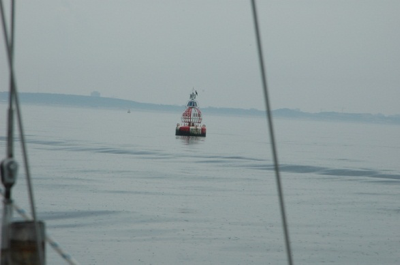 The predicted south-easterly wind dropped off again, right after setting the sails and heading south. So the tidal current and the started engine had to take us along the coast to our destination, 27 miles off. As forecasted, the sky was clouding over and it started to rain. The approach buoy “Scheveningen”, precisely this historical place, where we had to bury Reiner’s ashes came closer, but still far away, when there was appearing something strange from behind. Just a glance, but Corinna directly noticed it. What was it? There, again! A disappearing fin, followed by a gentle tail punch. There, another fin. Already two. Dolphins? Whales? Or what? We could not trust our own eyes, impossible here in the grey, silent North- sea. But evidently there were small dolphins, crossing our backwash, elegant and joyful. Who the hell Reiner has sent us? An omen? With speechless goose bumps we forgot anything else, unable to say a single word. The current led us further south, and after a while a small, dark dot emerged on the grey horizon, the approach buoy. Our whale-euphoria turned into a long silence of memories. The buoy was nearing. Our throats felt constricted. We surrounded the buoy, a moment of silence. Only the diesel engine was running in neutral, singing his song, sonorous bubbling on all of his four pots. La paloma ohé, auf matrosen ohé!
The predicted south-easterly wind dropped off again, right after setting the sails and heading south. So the tidal current and the started engine had to take us along the coast to our destination, 27 miles off. As forecasted, the sky was clouding over and it started to rain. The approach buoy “Scheveningen”, precisely this historical place, where we had to bury Reiner’s ashes came closer, but still far away, when there was appearing something strange from behind. Just a glance, but Corinna directly noticed it. What was it? There, again! A disappearing fin, followed by a gentle tail punch. There, another fin. Already two. Dolphins? Whales? Or what? We could not trust our own eyes, impossible here in the grey, silent North- sea. But evidently there were small dolphins, crossing our backwash, elegant and joyful. Who the hell Reiner has sent us? An omen? With speechless goose bumps we forgot anything else, unable to say a single word. The current led us further south, and after a while a small, dark dot emerged on the grey horizon, the approach buoy. Our whale-euphoria turned into a long silence of memories. The buoy was nearing. Our throats felt constricted. We surrounded the buoy, a moment of silence. Only the diesel engine was running in neutral, singing his song, sonorous bubbling on all of his four pots. La paloma ohé, auf matrosen ohé!
Scheveningen kept us two more days and the weather forecast was about to be justified. Rain, thunderstorm, some sun beams and a very sharp wind from the south. The typical weather for Holland. Now traveling behind schedule, France seemingly disappeared. Britain as well. Once we aimed to cross the channel, if at all, at the most narrow and safe position. Calais-Dover or Dünnkirchen-Ramsgate. Today we had no other choice, than letting the stormy weather pass by, to inaugurate the new oven with delicious lasagna.
-
Acquaintance with Emma or Edith
Still southerly wind. Not really the direction to make good many miles over ground to reach foreign countries as desired and even our engine was already in charge for too long way.
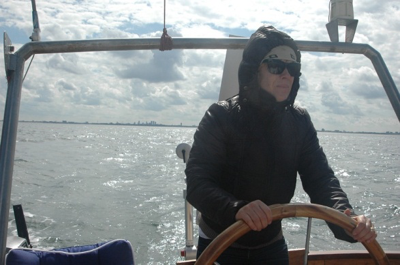 Next possible short-leg-stop: Stellendam, already in Zeeland, 10 miles south of Maas-mouth, the entrance to Rotterdam. The fairway is buoyed well and should not be an issue to pass, but still exciting enough in respect of the most frequented port entrance of the world. Annoying once again, the rough sailing up-wind. Again against the wind and also annoying the doubtful situation at the entry to Stellendam. We were told in Scheveningen, that the drawbridge before the inland harbor to Stellendam should be disturbed, but no one was really sure about that. As alternative it should have been permitted to berth alongside at one of the fish-trawlers at the outer docks.
Next possible short-leg-stop: Stellendam, already in Zeeland, 10 miles south of Maas-mouth, the entrance to Rotterdam. The fairway is buoyed well and should not be an issue to pass, but still exciting enough in respect of the most frequented port entrance of the world. Annoying once again, the rough sailing up-wind. Again against the wind and also annoying the doubtful situation at the entry to Stellendam. We were told in Scheveningen, that the drawbridge before the inland harbor to Stellendam should be disturbed, but no one was really sure about that. As alternative it should have been permitted to berth alongside at one of the fish-trawlers at the outer docks.
Belgium seemed to be too far for us two north-sea rookies, also due to the fact that the wind was still blowing adversely. Slowly, after having experienced the first week, we started to create plan B and C. And in the end we didn’t actually know how these plans looked like.
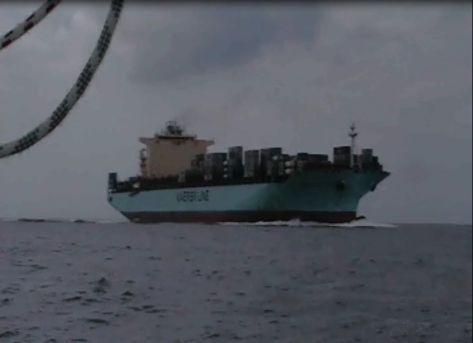 So we left Scheveningen with 20 knots wind, first reef into the main-sail and it worked well trimmed. But it was terribly cold. No summer at all. Pullovers and heavy off-shore-gear. But it was fun, cruising with nice speed up-wind, comfortable and reliable with few heel through the north-sea waves. Corinna at the helm, confidently sailing in accompany with the fat ocean-jumbos, no one was thinking about the self-steering wind vane. With the main, gib and genoa, the current calculated in the back, our small, chubby boat was running pretty fast.
So we left Scheveningen with 20 knots wind, first reef into the main-sail and it worked well trimmed. But it was terribly cold. No summer at all. Pullovers and heavy off-shore-gear. But it was fun, cruising with nice speed up-wind, comfortable and reliable with few heel through the north-sea waves. Corinna at the helm, confidently sailing in accompany with the fat ocean-jumbos, no one was thinking about the self-steering wind vane. With the main, gib and genoa, the current calculated in the back, our small, chubby boat was running pretty fast.
We could spot the very big ships very clear, even in their directions, but still not visible on our AIS. But even without the electronics we were able to pass without any excitement. With nothing else to do, I could film the more exciting location with the camcorder. In the distance an incoming containership, heading in parallel to us oncoming. We had this monster perfectly in view, kept safe distance. With an enormous speed we could identify the ship with our binocular as a “Maersk”-Liner. As it was constructed, it could have been only “Emma” or “Edith”, the biggest of their guild. Unbelievable how fast this giant was approaching. And something else was unusual. ‘Look’ my wife said, ‘take the rudder’. She pointed at the wake astern of the Maersk-giant, which was spreading v-shaped outwardly; a big wave rolling glossy, not green-brown as the north-sea, but emerald green. Not foaming and rough, but shiny, clear with smoothed flat surface. Also the difference in his height compared to the remaining waves around was conspicuous. Really curious. That was exactly how I always imagined a tsunami. But there was no time left for fascination, anxieties or even panic. ‘Nam Kok’ was still cruising unpertubed with more than 500 meters distance to the big vessel. Surely no danger of collision and on the VHF-radio we only heard the routine talks. Nothing special.
But this wave. This hammer. What was this about to become? The rest proceeded superfast and intuitively. Close before the wave reached us, I pulled our bow into the wind heading up, to hit the wave in the right angle, but concerned to overdrive or to provoke undesired tacking. It went so fast, that I wasn’t even able to advise Corinna to clear the sheets for that case. Like a cannonball we shot uphill on the green, glossy mountain. On top as on a roller coaster the bow tilt downward and we shot straight into the deep. The bow-pulpit drilled itself into the wave valley and a white wall of water infernally erupted like thunder struck, as if someone had tied our boat on a crane above a swimming pool and then cut the rope. Corinna escaped under the shade of the spray hood. I had to hold on tight on to the steering wheel and disappeared in the white, thundering water mass. There was only hysterical laughter left for me, completely crazy. Blessedly we still had speed and rudder left after this heavy punch, being completely under control and were not threatened to tack. So we could bear-down slightly on track again. After this, another green, glossy wave rolled in, but obviously smaller and not as dangerous as the one before.
That’s it. But what a knocker. Mamma mia…
Tranquilly cruising further and after being showered I forgot to check whether it was “Edith” or “Emma”? In the end it was not really important. Corinna at first had to step out to the lavatory and from under deck I heard Corinna shouting, that there was noisy water in our ship. The next shock! She ripped open the floor planks and indeed we had to face water ingresses; also water under the cabin-ceiling. What was going on? For heaven sake we rapidly realized that we did not make any further water and the spook seemed to be terminated. It was only sea-water, obviously flushing through the sea valves even up to the cabin-ceiling, in the toilet and into the bilge. Still on the sea, Corinna bailed 30 liters of sea water containing sand, stones and even some small mussels. But no fish…
What a whopper, another lesson.
As predicted we had been invited to a cozy berth at a fish-trawler to some romantic nights in the fisher-docks later on. The bridge in Stellendam indeed was defect and impassable.
-
Ride around the seal bank
Monday, 9th of july, 11th day of our trip. Covered sky, some rain, 16°C. Wind blowing west-southwest, veering in the evening. But now it was sealed, we were committed, the point of return. It appeared stupid and senseless to continue against the wind. The Belgian and French courtesy ensign could be stored away, also that one of the Queen. Thankfully not completely learn resistant, we had to accept the new situation, also because of the hopeless weather reports for the coming weeks.
Turn around!
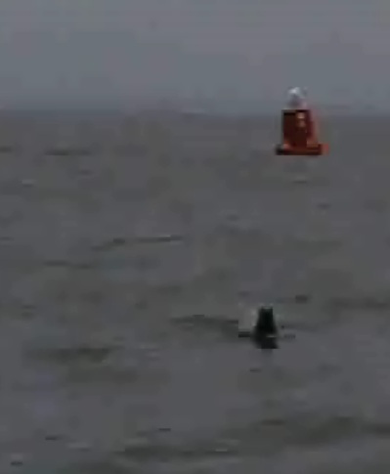 The diesel powered on full cruising speed, in order to get out of the deep bay, wind-and westwards, we had no other choice than motoring through the fairway of Stellendam to the open sea, until the way to Rotterdam should be clear, back to the north. In front of us, another smaller sailboat, heading to England, which later had to surrender and to return. The nearer we came to the open sea, the rougher it got. Corinna and the engine had difficulties taking us forward. But she did not want to give up and to return as well. Again and again the churning sea nearly stopped us. Over and over again the white water whooshed over the deck. Corinna was so concentrated, that she apparently gave up any kind of thinking. I stood in front of her, watching the hustle, entirely bewildered. For me myself it was not understandable, how to leave the harbor under such circumstances, to steam with the engine 1 ½ h against the wind. Foolish and not my philosophy of sailing. First doubts came up, but we always had been in the position to return back to Stellendam anytime. So come on. The last buoy at the end of the fairway windward came slowly in sight.
The diesel powered on full cruising speed, in order to get out of the deep bay, wind-and westwards, we had no other choice than motoring through the fairway of Stellendam to the open sea, until the way to Rotterdam should be clear, back to the north. In front of us, another smaller sailboat, heading to England, which later had to surrender and to return. The nearer we came to the open sea, the rougher it got. Corinna and the engine had difficulties taking us forward. But she did not want to give up and to return as well. Again and again the churning sea nearly stopped us. Over and over again the white water whooshed over the deck. Corinna was so concentrated, that she apparently gave up any kind of thinking. I stood in front of her, watching the hustle, entirely bewildered. For me myself it was not understandable, how to leave the harbor under such circumstances, to steam with the engine 1 ½ h against the wind. Foolish and not my philosophy of sailing. First doubts came up, but we always had been in the position to return back to Stellendam anytime. So come on. The last buoy at the end of the fairway windward came slowly in sight.
Now or never, due to the weather it was the last chance to leave the soul- and characterless fishing harbor of Stellendam. That was motivation enough. The buoy came closer, the waypoint on our way to the north. The sea was foaming heavily, no end of pitching and rolling. But suddenly an escort! A big black head appeared from astern. A seal! He was watching us along time, amused or fascinated, diving up and down, as if he wanted to guide us the right direction. He was so close, that we could nearly see his hair of the beard. For a short moment we forgot everything around us, more amused than fascinated, very delighted.
Finally we reached the waypoint buoy ‘hinder’ and then the big moment. Ready to set the sails. In this moment my wife thought, I was perfectly gone crazy, to set the sails right now and under these conditions, but the way was open now on half wind. The sails should rather stabilize us and also the escape route back was still open- that were my arguments. Now or never.
Slower than usual I moved on deck, hand over hand along the reeling, hooked my lifebelt in the mast and set the main sail with one reef. Corinna controlled the ship magnificently in precisely in the wind, so that I had an easy game. The sail was quickly up, beating in the wind with horrible noise. Slowly I returned to the cockpit. The boat was rolling and pitching with beating main sail; Corinna speechless and pale. Bear-down, main- sheet tight and go. Immediatly we took 5 knots of speed. Engine off. Everything quiet, only the howling of the sea. True sailing.
Now the Gib out. I immediately decided to put out also the small headsail and stepped to the very front. Everything was ready. After several showers on the bow deck section, the second sail was up. The ride began to become racy and the log needle climbed up to 7 knots boat speed. We didn’t look back anymore, being confident to reach the harbor entry of Rotterdam at one leg. Meanwhile shortly past five o clock, the sea was rolling with white caps on the waves. We were flying with “Nam Kok”, as well as everything below deck was flying that wasn’t thoroughly stowed. But sailing on halfwind was obviously too rustic and temporarily even fearsome, when a very steep wave was tackling from the side. Slightly up-wind it appeared perfect and the little, chubby “Nam Kok” steamed through the waves, dashed straight forward with everything she had. The pivot swing keel rumbled noisy and annoying and had to be ignored. The boat was right in its element. Like never before we were riding on the sea, even surrounding the seal bay in the east, which was still visible due to the white breakers. Our view was strongly directed to the happenings, the horizon and in particular to the waves. How easy it was, to navigate playfully through the steep waves; we were racing undeviatingly, nearly with hull speed. The chart plotter was running as back-up to insure track and destination. We gained comfortable way up-wind. Despite that my wife still felt a bit fishy.
On this way, as we were heading slightly up-wind, we would surely fail the harbor entry. After a bit more of half of the way it was time to take the waves inclined from astern on broad reach, now on track to Rotterdam. The ‘Nam Kok’ was riding in extasy. Full speed ahead. With trimmed sail we were running down the waves, the log needle trembled higher and higher; no chance below 8 knots anymore. Even me as the helmsman felt completely high and forgot, to my own shame, to set the boom-preventer. We were flying. I remembered my time as a surfer, with the difference, that I now that to maneuver 12 tons, instead of 12kg. But “Nam Kok” was gloriously laying on the rudder, obeying the directions on tight reins. 9.5 knots, nearly 10, we were surfing over hull-speed downhill. Top speed. An euphoria- but also no easy game in this area, where the biggest ships of the world were approaching. However we rushed towards our destination and on this course we would have to cross the fairway. “Jibe. We will jibe. Clear for jibing.” Corinna appeared astonished. “You mean jibing with this breakneck speed and wind”? “ Yes, right. Jibing. Once your ready, we bear down and turn. Behind us a container ship is approaching. We have to keep clear. Anyway, jibing is our best skill”, beating arguments. Safely the boom swang over and we remained speeding furiously on broad reach, now on new tack. The container ship could pass and we were able to follow him after another maneuver like that.
On VHF we were already registered and accepted at the entry by “Maas-Traffic-Control” for final approach. Now we were on their screen and under their guidance. They advised us to stay on stand-by. So I stowed away the mainsail, getting further, powered by the engine again. Breath and pulse calmed down; we did it.
Only 3 hours left to reach the marina of Rotterdam, with the tidal current in the back. Another incoming vessel overtook us, a Japanese one. On the bridge nearly 10 seamen, that appeared everything else but relaxed. From the distance, they looked kind of upset, and with our binoculars we could see it. They wanted to tell us something. One of them was waving a walkie-talkie, the other ones were pointing vehemently to the river-side. We were clueless, until Corinna had an idea. “There a sign-board, VHF 18! Another channel. We have to switch!” we switched to channel 18 and shouted “Wah - kalli- masch taa” ( I understood ) to the Japanese seafarers. The crew laughed, nearly bending due to my modest Japanese language skills. Obediently we also returned to “Maas-Traffic-Control” and confirmed again our availability with excuses for being absent. We were under control again, in concert with the real big ones.
The western horizon in the fairway astern provided an awesome ambience. Just as being 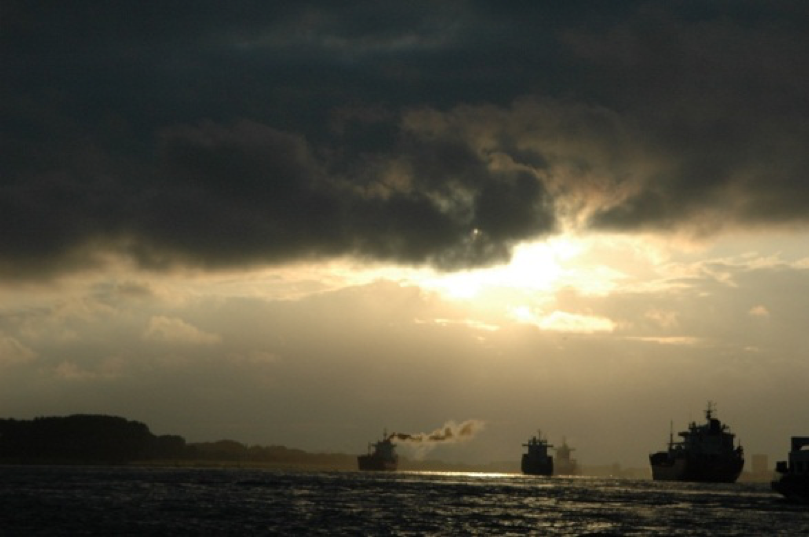
on a theater stage the sun was beaming in yellow-orange colors, through the black, dramatic clouds- a spectacle. Only with difficulties we could suppress our emotions, packed with the happenings of our sailing day. What a wonderful, touching atmosphere with the sea of lights at the beginning of the night.
Just before eleven o clock at night. Entry Veerhafen, in the middle of the city in front of the modern, illuminated Erasmus-bridge. The wind had calmed down. We landed with the tail to the pier, promptly being welcomed by Bert, the harbor master. Champagne for everyone- we have deserved that.
-
Rainy days in Rotterdam
No hurry anymore. No further aims to move southwards, no longer sailing upwind, but also no flying courtesy ensign and moreover no Queen. Stellendam was the turning point of our journey, since yesterday we were heading home, ten days left to return via “Staande mastroute”, the inner Netherlands waterway from Rotterdam to Amsterdam. Relaxing was now the most important thing for us after all these happenings. But in first instance the broken Erasmus-bridge was about to refuse the continuation of our travel. We didn’t care. For hours the pattering rain invited us to chill lazily below deck- even more than lazy, sleeping nearly with no end, until the first, cool prosecco popped up in the afternoon. Like this, it went on for days…
Every day we were put off with bad news regarding the failed repair of the Erasmus-bridge. Slowly but surely it became annoying.
13th of July, 2012. A lovely autumn morning. Behind the beautiful boathouse from the colonial era, a glorious avenue leads to the city centre. Some ladies, marching to their offices, were dressed in autumnal colored tights beneath stylish pencil-skirts, another showed up with fancy wool-mini dress and overknee-boots; the gentlemen with umbrellas and colored scarves. Continuous rainfall, actually a hopeless case, but this marvelous view on the cat-walk could cheer me up, even for the length of a not less marvelous cup of coffee.
Neither the fashion show, nor the visit of the museum, nor 5 minutes outbreak of sun could warm us up entirely and we got accustomed to lethargic board routine. But there was hardly no other chance, the bridge wasn’t about to open, so-called an electronic control problem. Unbelievable.
-
Tug assistance to Vlaardingen
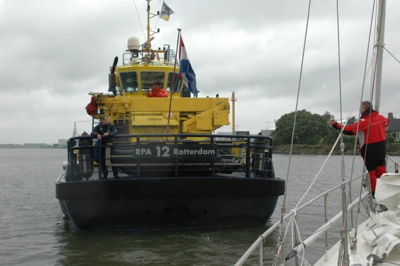 Indeed, four days with more than sufficient recovery in Rotterdam were enough. The rain wasn’t about to decrease and also the cold wind was howling for a long time from south west. The north-sea seemed to be impassable to us and other crews who had the same thought consorted with us to a convoy, ready to circumnavigate the still defect Erasmus-bridge. An exhausting, one day long detour, but slowly the time was running by.
Indeed, four days with more than sufficient recovery in Rotterdam were enough. The rain wasn’t about to decrease and also the cold wind was howling for a long time from south west. The north-sea seemed to be impassable to us and other crews who had the same thought consorted with us to a convoy, ready to circumnavigate the still defect Erasmus-bridge. An exhausting, one day long detour, but slowly the time was running by.
At first the way lead us back straight to the north-sea, but after 5 miles we bent off into Oude Maas. The convoy pulled apart; the boats in front didn’t care about the appointed 6 knots speed and edged off. In front of us another flap bridge: the Botlekbrug. The railroad bridge, which opens only 3 times a day, was already open and we accelerated to get through the bridge as the last ones of the group.
Suddenly, only 100 meters in front of the bridge: ALARM! Water temperature 120°!!! 120 degrees on our engine monitor! We immediately throttled down and sent a radio call to the bridge: “We cannot pass, we are in serious troubles!” I jumped down to the engine which had already covered the whole cabin with steam. Luckily it was steam, no smoke. We were not burning. How appeasing.
Unfortunately we were drifting right in the fairway, so Corinna pulled us with low speed to the riverside, thus windward and away from the buoyed fairway, while I was preparing the anchor to drop. Anchoring! Engine STOP, to avert bigger damage, sharp wind and current against us. The rotten anchor wasn’t about to grab and we drifted over the waterway leeward. The echo sounded more than 30 meters depth, so of course the anchor couldn’t grab. We drifted further and further, crossing the water street again, straight towards a discharging station of a petrol tank. I took out the complete anchor chain and felt how the anchor was slipping over the ground until he finally hooked in. The chain was tightened and our boat came to stop. We dropped a security call, to report our position and damage. Botlekbrug calmed us down, informing us about a tug, which was already on the way.
In the meantime a huge, brandnew motor-yacht turned, obviously for assisting us. Regrettably they did not take our VHF-calls, so we had to shout. The young skipper laced a remote control around his big belly, with which he obviously could control the ship. Apparently he was not less nervous than we were, although the anchor held safe and tight. We handed over the towrope, but he didn’t understand despite several hints, that our anchor was still dug in. So he maneuvered his yacht in a very strange way, until he finally crashed us with his full side. He bent our bow-pulpit, got himself a very big damage, threw the towrope overboard and whooshed away. Again we were stunned.
Quickly the tug arrived from the other direction, being alarmed by the operator of the Botlekbrug. Experts with 10.000 hp. It was immediately clear, that those guys were used to deal situations like this in another manner. First they told us what they intended to do, while they were surrounding us with their huge tug. We threw over the towrope, they fixed it and speeded up very smoothly. The anchor chain relaxed and our own batteries obviously had enough power to release the anchor without engine support. Free again the tug brought us to safety. We turned back towards Rotterdam again and finally to the entry of Vlaardingen. Even there, everyone was already informed and waiting for our landing, when the huge tug dropped us tenderly at the waiting quay of the lock. We got weak in the knees. The tug-crew talked about a daily and easy job, rejecting tip or even red wine.
What was the reason for the damage? Right away we started to investigate the root cause, supposed to be in the secondary sea-water-cooling-circuit. Directly we were on the right trail. The impeller of the water pump was not driven anymore. We quickly dismantled the pump, found a worn out nut of the aluminium-disk on the engine, which should drive the pump-claw. The constructive inaccessibility was already present five years before, but been disregarded. Now we pitiless received the bill. We had to get a new aluminium-coupling very fast. Every store was already closed as every Saturday. But our supplier in Germany had the spare part on hand and promised to send it via turbo express to a café in the village. Our job was finished for now.
Now we only had to wait. So we drowned with a lot of genever and pilsjes (Lager-beer) in the bars and pubs in the harbor next to the town. The harbor was presenting itself spacious and much more comfortable. But we were moored in front of the lock of the harbor, driveless. Corinna started to cry over and over again, even the genever couldn’t manage to help. To me, it did.
Sunday morning: Meanwhile a sailboat from Belgium, a guy with his three son was moored side by-side to us. Another smaller, english sailboat the “Explorer” from Lowestoft behind us. Together with the lock keeper we tried to convince the Belgian sailor to tug us into the inner harbor. But with his charming, smart accent he delivered a lecture, why this wouldn’t work: his ship was too small and too weak, the “Nam Kok” too big, heavy and fat. The walls of the lock too high and the wind, which didn’t blow, was too strong. The English crew took note of all the excuses in amusement. Catherine, Mrs. Captain, a typical end-of-forty-lady, smart with nerd-glasses and plenty humor immediately stepped in. One could try, even if their ship was smaller and lighter than those of the Belgians. Why not? All together we moored off. The Belgian first, to clear us from the package, me with our tender dinghi and 5hp outboard motor and then the “Explorer”. Suddenly the Belgian was back in the game. Unasked he took a towrope of the “Nam Kok”, gave several commands without any agreement and caused a huge chaos until he noticed that he was needless, ignored by everyone and left. Without words we already spoke one voice with “Explorer”. The bridge to the lock opened and “Explorer” with its 20hp diesel started to pull. Mike, one crew member of “Explorer”, well supported Corinna on board of “Nam Kok”. With the dinghy I tried to brake in the front, to push from the back and on the side as good as possible. A crowd of people watched the spectacle and was very impressed; the two ladies at the helm had the situation perfectly under control, dropped us gently at the target quay in the inner harbor.
The crew of the “Explorer” wanted to say goodbye very quickly, but fortunately another cloudburst stopped them. So it was quite easy to invite and to convince them for a 5 o’clock-tea, as little revenge for their great contribution. Catherine, Mike and Roy came 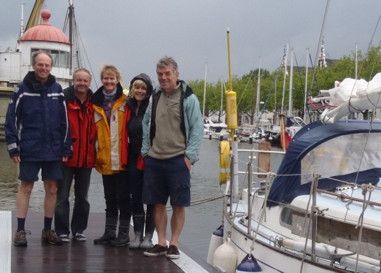 on board with an awesome typical tea cake, riddled with crystallized fruit and raisins. They couldn’t believe, we were also having tea with milk. They told us stories from England, Lowestoft, the history of the community ship “Explorer” and their trip. The boat was navigated by different crews of the “Kessingland Sea Sailing Club” in the Netherlands, aiming to sail the north sea, which was considered to be only passable for freaks, and therefore their trip was now about to finish in Rotterdam with the handover to the next crew. And that it was, where Catherine, Mrs. Captain was heading to, motivating her crew for the last leg. Even the farewell was very warm and hearty; my darling got a first impression of british sense of humor, seamanship and cosiness.
on board with an awesome typical tea cake, riddled with crystallized fruit and raisins. They couldn’t believe, we were also having tea with milk. They told us stories from England, Lowestoft, the history of the community ship “Explorer” and their trip. The boat was navigated by different crews of the “Kessingland Sea Sailing Club” in the Netherlands, aiming to sail the north sea, which was considered to be only passable for freaks, and therefore their trip was now about to finish in Rotterdam with the handover to the next crew. And that it was, where Catherine, Mrs. Captain was heading to, motivating her crew for the last leg. Even the farewell was very warm and hearty; my darling got a first impression of british sense of humor, seamanship and cosiness.
-
Staande Mastroute with the Explorer
After two naturally rainy days in Vlaardingen, our engine was running again. Shortly after mooring off, it again turned serious. With showers, the cold as usual, fortunately powerful wind from astern, we got Botlekbrug in sight again, the second attempt. The engine powered reliable , as ever. We went upstream the Oude Maas with the wind in our back. Again in a convoy of five and in front of us a remarkable sailboat. Pretty, slim and small, 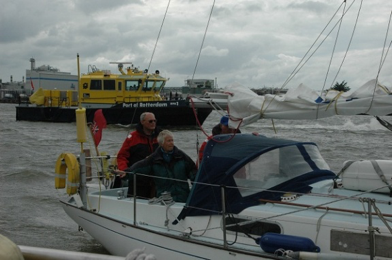 sailing with genoa. We came closer and could recognize the “Explorer” with our binoculars. Indeed it was “Explorer”, what a surprise. Happiness all over on board. While overtaking we tried to contact to the new crew. Then we briefly explained them on VHF 71 about our first meeting with the former crew and the tug maneuver. Together we cruised up the Maas-stream, supported by our rolled out genoas at bitchy gusts. From then on we have been inseparable. Again 2
sailing with genoa. We came closer and could recognize the “Explorer” with our binoculars. Indeed it was “Explorer”, what a surprise. Happiness all over on board. While overtaking we tried to contact to the new crew. Then we briefly explained them on VHF 71 about our first meeting with the former crew and the tug maneuver. Together we cruised up the Maas-stream, supported by our rolled out genoas at bitchy gusts. From then on we have been inseparable. Again 2 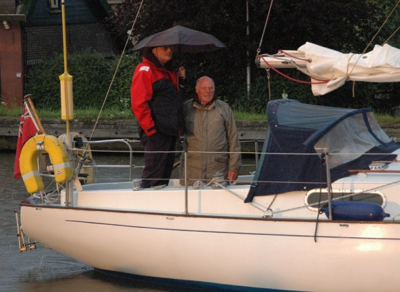 boys on board, or better say two seasoned gentlemen. Peter, a retired Naval Architect and Marine-Project-Manager. Bob, a Senior Hospital Anaesthesist and Hyperbaric Doctor, off duty. And Anni, a lady of equal age, former Midwife. All three know each other from their youth, having sailed thousands of miles together. Every day they changed “Explorer”s commander, sometimes with some growling vibes, but at the end of the day there was blissful and undoubted, adorable harmony. No effort was needed to get acquainted; somehow it felt already done and we had all a perfect idea, how the others ticked and conversely.
boys on board, or better say two seasoned gentlemen. Peter, a retired Naval Architect and Marine-Project-Manager. Bob, a Senior Hospital Anaesthesist and Hyperbaric Doctor, off duty. And Anni, a lady of equal age, former Midwife. All three know each other from their youth, having sailed thousands of miles together. Every day they changed “Explorer”s commander, sometimes with some growling vibes, but at the end of the day there was blissful and undoubted, adorable harmony. No effort was needed to get acquainted; somehow it felt already done and we had all a perfect idea, how the others ticked and conversely.
It took us four days to reach Amsterdam, traveling side by side, agreeing upon every stage 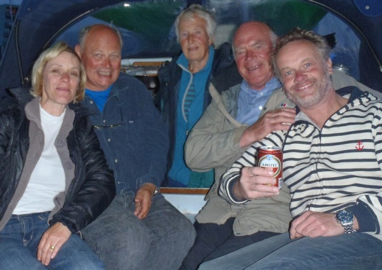 and maneuver, even the shopping list and dinner arrangements. We only spoke English, talking about old times and sailor’s yarn, tried every beaujolais of our non-existing wine cellar, while having self-made tortilla in the cabin. Joking, singing, drinking, laughing, not even one joyful attitude, which also Reiner would characterize, has been left out, feeling familiar between sincere, charming and companionable sailors, finally the best opportunity and pleasure to fly the british courtesy ensign as appreciation. God save the Queen!
and maneuver, even the shopping list and dinner arrangements. We only spoke English, talking about old times and sailor’s yarn, tried every beaujolais of our non-existing wine cellar, while having self-made tortilla in the cabin. Joking, singing, drinking, laughing, not even one joyful attitude, which also Reiner would characterize, has been left out, feeling familiar between sincere, charming and companionable sailors, finally the best opportunity and pleasure to fly the british courtesy ensign as appreciation. God save the Queen!
4 days long we passed as convoy of two along fields and the typical, dutch countryside, occasionally sheltered with umbrella on deck as exemplary, english reply to the also typical and never ending rainfalls. We also crossed a beautiful passage in Haarlem surrounded by thousands of people at the edge of the canal. All the former inconvenience had been blown away, being part of the past. Even the weather was calming down at the end of our holidays. The only thing that was for sure, we wouldn’t reach the port of departure in time on Sunday. So we had to figure out an alternative and targeted the harbor “Twelega”, located east in Amsterdam, to leave the ship there until next Friday. With our English friends we spent the last evening together under a starry sky and slowly looming summer, perfectly in due time. For me and my wife, the circular trip ended up in Amsterdam. The most beautiful and grateful section of our journey clearly belongs to the two trios of the “Explorer”.
-
Rolling home
The last two legs on the following weekend. In the way we had interrupted the trip, we returned back to the “Nam Kok” by train. Moored off the day after, we passed the “Pääd” of Marken and were welcomed in Enkhuizen by the incoming “Flying Fish” from Warns, meeting on half way. As well a lovely crew.
Blasting gusts on our last day on the Issjelmeer. Rolling home with wind force 4 up to 7 and certainly with rain, together with “Flying Fish”. Initially we took the lead during our private regatta, but then quite early we preferred to put in a reef our mainsail, due to these bitchy gusts and had to acknowledge the pace of the “Fishes”; with impressive heel they sailed away, showing us their tail. That smells like revenge…
What was left of our former intentions at the end of our journey? We couldn’t agree about being relaxed. A miracle and even more fortune, that we are still in love. There was no lack of important experiences and happenings; we experienced “Nam Kok” substantially, gained a lot of confidence.
And finally with the outstanding acquaintance with ”Explorer” we indeed discovered new territory as desired, even more perceived and not with our feet on the ground. For us it does not make any difference; the feeling in our heart weights much more and that counts. My wife Corinna has been overwhelmed, yet again explored her kingdom at the end in particular way, even without the Queen.
If the mountain does not come to the prophet, than the prophet has to go to the mountain.
Havanna has to wait.
25.03.2013
Text: Frank Martin Steinbrecher
Translation: Helen van Laak
Mother tongue: George Austerfield